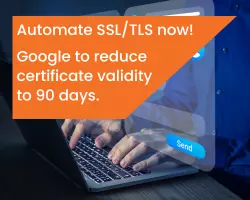If you work in cybersecurity, it’s highly likely you’re using AI already. In 2024, 93% of security leaders said their organizations were using Gen AI, and 91% were using Gen AI specifically for cybersecurity operations. The uptake of AI is only going to increase: 58% of organizations are planning to increase their AI investments, and among larger organizations, that figure rises to 70%.
There are many reasons for AI’s swift adoption, as there are huge benefits across multiple aspects of cybersecurity. In the specific field of certificate management, AI is playing an important role in enabling enterprises to handle the exponential growth of digital identities and certificates with unprecedented efficiency.
But AI could be a double-edged sword, due to hidden risks that, if left unaddressed, could undermine the very security protocols AI use should enhance. We need to understand these risks in order to introduce safeguards and protocols that allow us to maximize the immense benefits that automation can bring to certificate management.
- The Promise of AI for Certificate Management
- The Hidden Risks of AI in Certificate Management
- Mitigating AI Risks in Certificate Management
The Promise of AI for Certificate Management
You’re probably already feeling the impact of AI in certificate management. It can automate certificate lifecycle processes (issuance, renewal, revocation, and compliance checks), which reduces human error and operational latency.
You can apply machine learning models to detect anomalies in certificate usage, such as unauthorized SSL / TLS certificate requests or deviations from standard validation protocols, allowing teams to prepare and mitigate the threat.
If your organization is large enough to be managing thousands of certificates across hybrid environments, AI’s scalability ensures seamless coordination of cryptographic keys and digital identities. This is an obvious and crucial advantage in an era of zero-trust architectures, affecting even Wi-Fi networks in the context of how certificates are used.
AI’s efficiencies are sealing many previous gaps in cybersecurity, but they could also be introducing new risks. However, the same algorithms that streamline workflows also introduce vulnerabilities that malicious actors can exploit.
The Hidden Risks of AI in Certificate Management
In order to utilize AI effectively for certificate management, you also need to understand the hidden risks that come along with it. It’s only by understanding the risks involved that you can formulate proactive strategies to prevent and mitigate them, which will in turn allow you to reap the full benefits of your own AI usage. Here are the most important risks that AI could pose to certificate management.
AI Data Poisoning and Model Exploitation
Your AI systems need massive datasets to train models for tasks like certificate validation or threat detection. Attackers can manipulate these datasets through ‘data poisoning’, injecting malicious samples that skew your AI’s output.
A poisoned dataset could train a model to misclassify fraudulent certificates as legitimate, enabling man-in-the-middle attacks or unauthorized access. Similarly, adversarial attacks, which are subtle input modifications invisible to humans, can trick AI into bypassing validation checks. A compromised model might approve a forged certificate with altered metadata, undermining the integrity of your Public Key Infrastructure (PKI).
Prompt Injection and Algorithmic Loopholes
Generative AI relies on the correct prompts and inputs for effectiveness. But this opens the systems to risks like prompt injections, where attackers craft inputs to manipulate AI-driven systems.
When it comes to your certificate management, a malicious prompt could trick an AI tool into disclosing sensitive PKI details or generating fraudulent certificates. An attacker might exploit a vulnerability in an AI-powered Certificate Authority (CA) to issue valid certificates for spoofed domains, enabling phishing campaigns or SSL stripping attacks.
AI as a Tool for Attackers
While AI can bolster your security, it can also empower your adversaries. AI enables attackers to automate certificate-related exploits at scale, allowing them to brute-force weak cryptographic keys or generate polymorphic malware signed with stolen certificates.
One of the biggest impacts of AI in the hacker-sphere is on phishing campaigns. It allows bad actors to craft hyper-personalized emails that mimic legitimate certificate renewal notices, complete with forged digital signatures.
Mitigating AI Risks in Certificate Management
All the risks that exist in the intersection of AI and certificate management require proactive steps to prevent and mitigate them. Cybersecurity professionals and their organizations can’t afford to wait for attacks to happen, so let’s take a look at what you need to be doing right now.
Robust Data Validation and Zero Trust
You can counter data poisoning by implementing robust data validation frameworks. You can use anomaly detection algorithms to flag suspicious training data and combine this with continuously monitoring your certificate issuance logs for irregularities.
Pairing AI with a zero-trust architecture ensures that every certificate request, even those approved by AI, undergoes strict identity verification and least-privilege access controls.
These principles can be applied across all of your networks. If you’re using a Content Delivery Network (CDN), you can use techniques like delegated credentials.
In this model, the certificate owner uses a private key to create short‑lived delegated credentials that the CDN can use for TLS handshakes.
Dynamic Monitoring and Adaptive Incident Response
Maintaining resilient certificate management requires continuous, real‑time oversight. You can integrate AI-driven analytics with advanced threat intelligence to allow your systems to monitor certificate issuance logs dynamically. It will spot subtle deviations, abnormal issuance volumes, or unauthorized access attempts before they escalate into full-blown breaches.
You can combine this with machine learning models to continuously analyze patterns in certificate activity, allowing for early anomaly detection and rapid, automated alerting. When these systems work in tandem with adaptive incident response protocols, your security team can quickly recalibrate access controls and update risk models in response to emerging threats.
This dynamic approach not only narrows the window for attackers but also ensures that any AI-enabled manipulations are addressed promptly, reinforcing the integrity of your certificate management infrastructure.
Strict Identity Verification
Integrating strict identity verification into certificate lifecycle management is essential to counter the hidden vulnerabilities introduced by AI in certificate operations. Organizations can substantially reduce the risk of AI-powered attacks by rigorously verifying the identity of every entity at each step, including issuance, renewal, and revocation. This dual approach not only ensures that only legitimate certificate requests are processed but also fortifies the overall public key infrastructure, making it far more resilient against tactics like data poisoning or prompt injection.
Managing this process can be greatly assisted by automating the monitoring, renewal, and revocation processes to provide continuous oversight that adapts to emerging threats and anomalies in real time. This dynamic management framework ensures that certificates remain current and secure throughout their lifespan while swiftly isolating and remedying any detected deviations.
Conclusion
AI’s role in certificate management may be a double-edged sword, but with proactive mitigation and effective automation, you can reduce these risks. As PKI evolves alongside AI, you must prioritize frameworks like zero trust and invest in adaptive security solutions that keep pace with your adversaries’ innovations.
A major first step is partnering with a trusted PKI provider that integrates AI responsibly. You need to explore AI-driven certificate management solutions grounded in robust risk mitigation, and ensure your cryptographic key infrastructure remains resilient against both current and emerging threats.
Note: This blog article was written by a guest contributor for the purpose of offering a wider variety of content for our readers. The opinions expressed in this guest author article are solely those of the contributor and do not necessarily reflect those of GlobalSign.







